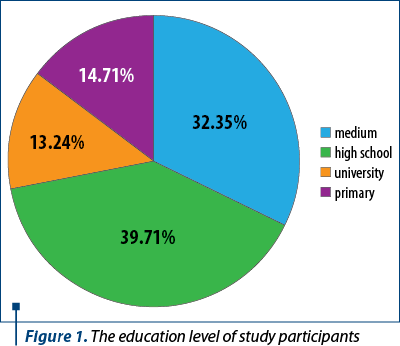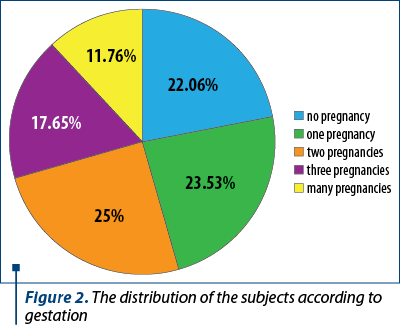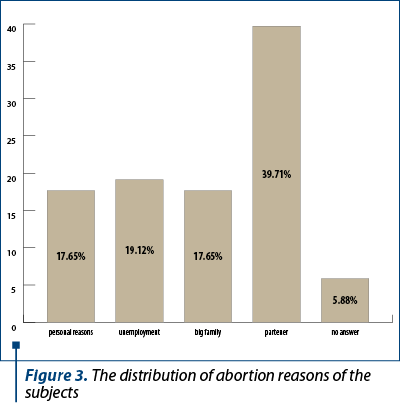Factorii psihosociali care determină avortul la cerere – experienţa noastră
Psychosocial factors involved in the termination of pregnancy – our experience
Abstract
Introduction. The lifestyle of each partner, the parent-child relationships and the entourage endanger the normal course of pregnancy through economic, educational and ethnic interests, and in these situations, voluntary abortion occurs. The purpose of our study was to evaluate the factors that determine the decision for the termination of pregnancy.Materials and method. We realized a prospective study that included patients who presented for abortion on request at the “Bucur” Maternity Hospital, “Sf. Ioan” Emergency Clinical Hospital in Bucharest, between April 2018 and June 2018. Those patients were interviewed using a self-questionnaire.
Results. The study included 68 patients who presented for abortion on request. The patients from the studied group were between 15 and 45 years old (mean 25.7 years old, standard deviation 7.33). Our analysis identified that 52.9% of the women from our study were married. The majority of women were Orthodox Christian (79.41%). Regarding the ethnicity declared by the patients, the majority were Romanian (60.3%), followed by Roma women (36.8%) and 2.94% undeclared. We made an assessment of termination of pregnancy reasons, and we found out that the main reason were the disagreements with the partner (39.71%), seconded by the lack of employment (in 19.12% of cases).
Conclusions. The familial and economic factors were decisive for the voluntary termination of the pregnancy. Many of the women interviewed reported that they would use the method again in the future. Overall, low-income young women are most likely to request abortion.
Keywords
abortionfactorstermination of pregnancyRezumat
Introducere. Stilul de viaţă al fiecărui partener, relaţiile dintre părinte şi copil, dar şi anturajul pun în pericol cursul normal al sarcinii, prin mijloace economice, educaţionale şi etnice, iar în aceste situaţii se produce avortul la cerere. Scopul acestui studiu a fost evaluarea factorilor care determină decizia de întrerupere a sarcinii.Materiale şi metodă. Am realizat un studiu prospectiv care a inclus paciente care s-au prezentat pentru avort la cerere la Maternitatea „Bucur”, Spitalul Clinic de Urgenţă „Sf. Ioan” din Bucureşti, în perioada aprilie-iunie 2018. Aceste paciente au fost intervievate cu ajutorul unui chestionar propriu.
Rezultate. Studiul a inclus 68 de femei care s-au prezentat pentru avort la cerere. Pacientele din lotul studiat au avut între 15 şi 45 de ani (media 25,7 ani, deviaţia standard 7,33). Analiza noastră a identificat că 52,9% dintre femeile din studiu erau căsătorite. Majoritatea pacientelor erau creştin-ortodoxe (79,41%). În ceea ce priveşte etnia declarată de paciente, majoritatea erau românce (60,3%), urmate de femeile rome (36,8%) şi 2,94% nedeclarate. Am realizat o evaluare a motivelor de întrerupere a sarcinii şi am constatat că motivul principal au fost neînţelegerile cu partenerul (39,71%), urmate de lipsa locului de muncă (în 19,12% din cazuri).
Concluzii. Factorii familiali şi economici au fost determinanţi pentru întreruperea voluntară a sarcinii. Multe dintre femeile intervievate au raportat că vor folosi din nou metoda în viitor. În general, femeile tinere cu venituri mici sunt cele mai susceptibile să solicite avort la cerere.
Cuvinte Cheie
avortfactoriîntreruperea sarciniiIntroduction
The lifestyle of each partner, the parent-child relationships and the entourage endanger the normal course of pregnancy, through economic, educational and ethnic interests, and in these situations, abortion occurs(1,2). Age is an important factor in the occurrence of an unwanted pregnancy, because during puberty and adolescence there are significant changes in sexual behavior with the appearance of secondary sexual characteristics. At any age, an abortion may involve the appearance of psycho-behavioral and physical trauma(1,2). The purpose of our study was to evaluate the factors that determine the decision for the termination of pregnancy.
Materials and method
We realized a prospective study that included patients who presented for abortion on request at the “Bucur” Maternity Hospital, “Sf. Ioan” Emergency Clinical Hospital in Bucharest, between April 2018 and June 2018. Those patients were interviewed using a self-questionnaire.
The evaluated parameters were: age of patients, environment of origin, educational level, marital status, declared religious and ethnic group, pregnancy and parity, social and economic implications of pregnancy, abortion decision, complications and risks of abortion, and future family planning plans.
The information was centralized and analyzed using the SPSS analytical program, variant 25. The descriptive data analysis and correlations between parameters were performed by means of Pearson-type bivariate correlation. The value of p<0.05 was considered statistically significant.
Results
The study included 68 patients who presented for abortion on request at the “Bucur” Maternity Hospital in Bucharest. The patients from the studied group were between 15 and 45 years old (mean 25.7 years old, standard deviation 7.33). Regarding the environment of origin, it was observed that there was a homogeneous distribution. It was found that patients from urban areas were more numerous than those from rural areas in a percentage of 2.94%.
An important aspect of this study was the assessment of the educational level of women who wanted abortion. The statistical analysis showed that most of them had medium or high school education. The minority was represented by women with superior education, in a percentage of 13.24% (Figure 1).

In the present study, it was observed that no patient with higher education came from rural areas. It was also identified that, for all levels of high school, middle school or primary education, women came mostly from rural areas. An additional piece of information is that the older patients had high school studies and were from rural areas.
Our analysis identified that 52.9% of women from the study were married. Regarding the marital status and the residence origin, it was observed that the majority of married patients who performed abortion on request came from urban areas (29.41%), compared to unmarried women who were mostly from rural areas (27.94%). The marital status was also correlated with the educational level. Thus, we noticed that the dominant proportion of 27.94% of married women had high school education, and the minority was represented by those with university studies. By comparison, the superior proportion (23.53%) of unmarried women had medium studies, and the minority was also represented by women with higher education.
We interviewed all patients about their religion, but some of them did not declare it. The considerations were personal and we did not insist, according to moral considerations. Therefore, the majority of women included in the study were Orthodox Christian (79.41%).
Regarding the ethnicity declared by the patients, it was observed that the majority were Romanian (60.3%), followed by Roma women (36.8%) and 2.94% undeclared.
By evaluating the relationship between religion and ethnicity in women who performed abortion on demand, it was observed that most of them were Romanian Orthodox Christian, followed by women of Roma Orthodox Christianity. A novelty is that Roman Catholic women who requested abortion on demand had a higher proportion compared to Orthodox Christian Roma women.
The analysis of the relationship between the educational level, the marital status and the ethnicity of the patients showed that most of the patients with higher education who requested abortion on request were unmarried.
The current study assessed the correlation between patients’ educational level and their religion. It was found that the majority of Christian Orthodox and Catholic women who had an abortion on request had high school education.
The study group was analyzed regarding the obstetric history. It was identified that the majority of women were at their second pregnancy. There was a significant percentage of 22.06% of subjects who were nulliparous and, thus, at their first pregnancy. In the current study, there was no women with more than six pregnancies in their obstetrical history. Regarding the obstetrical history, in our study it was found that women had predominantly spontaneous births (48.53%) in their past. The percentage of patients who gave birth by caesarean section was 17.65% (Figure 2).

The economic implications were taken into account for the abortion decision. Thus, it was observed that the patients described such a reason in a significant proportion of 77.94%. The reasons for this category refer to reduced family or personal income.
The social implications were also interviewed to find out the cause of the abortion. In the present study, it was observed that the women who resorted to this surgical procedure appreciated that this decision was a result of a family context, in a proportion of 39.71%. Another significant percentage of 32.35% was that of women who considered the partner responsible for the abortion decision.
In this study, we assumed that each patient had a determining factor that led to the abortion decision on demand. Thus, we made an assessment of these reasons and found out that the main reason was the misunderstandings with the partner (39.71%), seconded by the lack of employment, in 19.12% of cases (Figure 3). Women who have applied for an abortion have also been interviewed if they knew that this medical procedure can have complications. A significant percentage of 61.76% of women admitted that they knew.

The patients included in the study were evaluated for the use of other contraceptive methods. An alarming 67.65% of them did not use other means of contraception. The women included in the study were asked about other known methods. It was observed that a proportion of 38.2% of women had heard of contraceptives, but most of them knew about condoms (67.6%). A proportion of 8.8% of them did not know any other method of contraception (Figure 4). Regarding future contraception, most patients admitted that they will use contraception, in a majority of 64.71%. However, the percentage of those who did not want this was significant (35.29%).

An assessment was made for the relationship between the environment of origin, the level of education and the possibility of repeating abortion on demand, according to the response of the interviewed patients. It was observed that the highest possibility of repeating the medical act appeared in rural women with primary education (30%) and in rural women with secondary education (22.73%). The lowest chance of recurrence was for women with higher education (77.78%).
In total, we made all the statistical correlations between the parameters. In our study, it was observed that, from a statistically significant point of view, the most important determining agents for abortion on demand was the accumulation of factors represented by the young age and the economic implications. Thus, young women with low incomes had the highest chance of requesting the termination of a pregnancy.
Discussion
According to the World Health Organization (WHO), regarding the method to accomplish the abortion (on request, spontaneously or medically prescribed(1)), there is a major health problem, and Eastern European countries are most often incriminated(2,3).
However, there are countries that have restricted abortion since the late 19th century, and use this medical procedure only in special conditions, represented by sexual abuse, fetal malformations or maternal causes, which has led to an improved natality rate(2-5).
In Romania, the number of abortions decreased considerably after 1989, from 193,084 abortions registered in that year to 70,885 abortions in 2015(2). This was also associated with a decrease in maternal mortality from 170 deaths per 100,000 births in 1989 to 15 deaths per 100,000 births in 2005(3). The main factors that led to a decrease in the abortion rate was the use of contraceptive methods, family planning and patient education (from 38.4% in 2004 to 13.9% in 1993)(4).
Family planning and contraceptive methods have been used to prevent unwanted pregnancy, but also to prevent sexually transmitted diseases(5-7).
In Europe, the reasons for abortion have been classified according to WHO into: saving the patient’s life (96%), psychiatric illness (90%), the prevention of organic diseases (90%), fetal causes (88%), incest and rape (87%), economic and social reasons (79%), and on request (69%)(8).
By analyzing the situation of abortions in Romania regarding the reason, it was identified that it has changed over the years. In 1993, 60.8% of abortions were registered among women who did not want more children, 21.2% for socioeconomic reasons, 6.5% for disagreements with their partner, 4.9% for significant maternal and fetal risks, and 6.5% for other reasons(9). In 2016, the reasons for abortion were the fetal causes (65%), the maternal causes (20%) and the maternal-fetal reasons (approximately 15%)(10).
In the present study, there were included only patients with termination of pregnancy on request. The third decade of age characterized the majority of interviewed patients. The environment of origin was not a relevant factor for this analysis. The level of education was an important determining factor, because it was observed that women with higher education represented a proportion of 13.2% of those who wanted to terminate the pregnancy. Regarding marital status, it was identified that unmarried women requested abortion in a lower proportion compared to married women. We found that about half of the women in the study had used this method before, and 10% had never heard of contraception. By comparison, the literature describes a percentage between 3% and 56% for the use of contraceptive methods(11,12). According to our study, religion was not an important decision factor for the termination of pregnancy.
Conclusions
The women interviewed in our study reported family involvement in the decision-making process. The economic factor was also decisive for the voluntary termination of the pregnancy. Many of the women interviewed reported that they would use the method again in the future. Overall, low-income young women are most likely to request abortion.
Conflict of interests: The authors declare no conflict of interests.
Bibliografie
- https://www.acog.org/news/news-releases/2019/05/acog-statement-on-abortion-bans
- World Health Organization/European Regional Office (WHO/ERO), 2018. https://gateway.euro.who.int/en/indicators/hfa_587-7011-number-of-abortions-all-ages/
- World Health Organization/European Regional Office (WHO/ERO) European Health for All Database. 2009. http://data.euro.who.int/hfadb/
- Benson J, Andersen K, Samandari G. Reductions in abortion-related mortality following policy reform: evidence from Romania, South Africa and Bangladesh. Reprod Health. 2011 Dec 22;8:39.
- World Health Organization. Report of a WHO Technical Consultation on Birth Spacing. Geneva: World Health Organization; 2006.
- World Health Organization. Global and regional estimates of the incidence of unsafe abortion and associated mortality in 2003 (5th ed). Geneva: World Health Organization; 2007. https://apps.who.int/iris/handle/10665/69855
- Conde-Agudelo A, Belizán IM, Breman R, Brockman SC, Rosas-Bermudez A. Effect of the interpregnancy interval after an abortion on maternal and perinatal health in Latin America. Int J Gyn Obst. 2005 Apr;89 Suppl 1:S34-40.
- World Health Organization, Entre Nous. 2005;59. http://www.euro.who.int/data/assets/pdf_file/0004/69763/en59.pdf
- Bankole A, Singh S, Haas T. Reasons why woman have induced abortions: evidence for 27 countries. Int Family Planning Perspect. 1998;24(3):117-27.
- Olaru GO, Ionescu C, Lesnic A, Filipescu GA, Pleş L. Ethical and medico-legal aspects of the therapeutic abortion-our experience. Rom J Leg Med. 2018;26(1):82-5.





